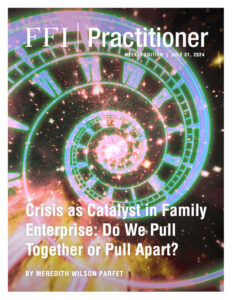
View this edition in our enhanced digital edition format with supporting visual insight and information.
Continuing our quarterly series on the FFI conference theme, “Mean Time: Time, Timing, and Timelessness in Family Enterprise,” through the month of July we are pleased to feature issues related to presentations that will be made in London in October. Thank you to Meredith Wilson Parfet for her article “Crisis as Catalyst in Family Enterprise: Do We Pull Together or Pull Apart?,” which includes her intersectional observations from her experience as a crisis management expert, hospice chaplain, and death doula.
Time does strange things when you’re in crisis—it manages to move both too quickly and too slowly at the same moment. You feel like you’re drinking from a veritable fire hose, unable to pause long enough to take a breath, yet you’re aware of every second of the experience in excruciating pain and detail. This gives some context to the origin of the word, derived from the ancient Greek word krisis, meaning:
A crisis is the literal demarcation of a moment of time, or a period of time, that causes us to question everything that we thought we knew or understood. It is a turning point caused by a negative event from which change must occur; there is no returning to “normal” because the landscape has inexorably shifted. We see things differently than we did before.
But what does it mean to be in crisis in modern times? Depending on who you ask, it could range from something as simple as a bad choice (think unfortunate corporate tweet) to much more serious events (think global pandemic, financial ruin, death and dying). But as both a crisis management expert as well as a hospice chaplain, I can tell you that an inappropriate tweet, while potentially damaging, is not actually life changing. What does change your life is catastrophic illness, the demise of a business, the death of a loved one, the failure of a marriage, the unraveling of a partnership, the loss of reputation, etc. And while it may seem surprising to mention death in parallel with professional crisis, there is a common thread—loss.
Something doesn’t need to be alive in order for it to die or for its loss to be profoundly mourned. Grief is grief. I see this in all aspects of my work. I sit with CEOs grappling with both the practical and emotional fallout of fatal workplace accidents, scandal, or bankruptcy. I also sit with the dying and their grieving families. In many ways, they’re not all that different—both involve listening to fears, talking about regrets, pondering existential questions, and literal or figurative hand-holding through pain. I serve as a guide. My experience has shown me that it is impossible to separate the personal and professional—one inexorably bleeds into the other. In crisis, those lines and boundaries become ever more transparent.
The lack of personal and professional boundaries is never more conspicuous than in family enterprise. Complex interpersonal dynamics, historical baggage, and diverging priorities can be tough to navigate on a good day, but combine generations of a successful family business with a major catastrophe, and the concept of an awkward Thanksgiving dinner takes on a whole new meaning. But it’s also a powerful catalyst. Nothing shakes loose hidden issues, or issues considered better left ignored, like crisis. It points to areas of alignment and misalignment. It often brings up feelings of responsibility, duty, loyalty, and resentment. It also creates the necessity for difficult conversations, the outlines of which have likely been brewing for quite some time.
Imagine the situation of an aging patriarch and CEO of a multigenerational family business who becomes suddenly ill. His son, out of obligation, reluctantly agrees to take over the reins of the company—a change in status that strains his relationship with his sister and mother, whose lack of visibility into business operations does not inhibit them from being vocal co-owners or of being resentful towards change.
All succession planning practitioners know that impending death is a terrible time to think through these issues. But even proactive succession planning misses the mark by not acknowledging that what we’re actually talking about is death and dying. We use euphemistic language such as legacy, vision, continuity, G1, G2, G3, etc., that overlooks the fact that we are talking about real people and mortality. It glazes over that, beneath the surface of discussions around succession, estate planning, transition of property, and the like, lie a million landmines of past relational wounds. Your clients might think they’re quibbling about what to do with Mom’s china but, subconsciously, the argument is often about who was the favorite child. Material possessions and financial bequests become placeholders for love and affection. This happens all the time, at some scale, across all families. When hard truths remain unsaid, a crisis will exacerbate any underlying conflict and tends to pull families further apart.
What if, instead, we leaned into having difficult conversations? Nine times out of ten, when people ask me “What should I focus on in death and dying?” my answer is connection. To the extent that the family members can connect, the rest sorts itself out. Who gets the silver? It doesn’t really matter as much if the family feels connected. But this isn’t just end-of-life advice. Not only is death the ultimate crisis, it also teaches us so much about how we want to show up during our lives. Death and dying sit at the center of every major wisdom tradition. It’s the center of Christianity with death in the resurrection. It’s the center of Buddhism with the Tibetan Book of the Dead. It’s the center of shamanic practices. It’s the center of mythology. You name it, death is one of the major principles of any tradition you can think of. It is one of the few aspects of life that everyone will experience. And it often provides much needed perspective for when other difficult things happen.
Should crisis hit, root out what gets in the way of connection. Ask yourself if the clients’ story involves old hurts, resentments, or losses. What emotions are being dredged up? What assumptions are they bringing? While families need to work collectively in crisis, our job as individuals is to untangle what’s going on in our own minds. Can advisors and clients be self-aware enough to separate the actual crisis from what they’re muddling together? While creating connection might not be able to heal old wounds, it goes a long way towards smoothing the path. Connection provides an anchor to weather the storm—something that holds families to solid ground.
Reference
1 “Crisis.” Online Etymology Dictionary. Accessed July 8, 2024. https://www.etymonline.com/word/crisis.
About the Contributor

Meredith Wilson Parfet is the CEO and Founder of Ravenyard Group, a crisis management consultancy with expertise in matters that involve legal or regulatory action, scandal, white collar crimes, large insurance litigation, or complex family office disputes. Meredith has nearly two decades of asset management, family office, and hedge fund experience. She also co-founded Denali Venture Philanthropy, an impact investment organization that funds entrepreneurs committed to social change. She is a certified End of Life Doula as well as a practicing Hospice Chaplain. She can be reached at meredith@ravenyard.com.

View this edition in our enhanced digital edition format with supporting visual insight and information.





